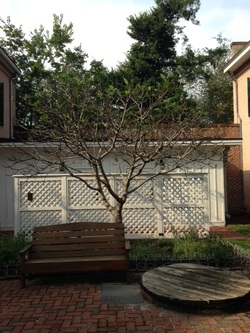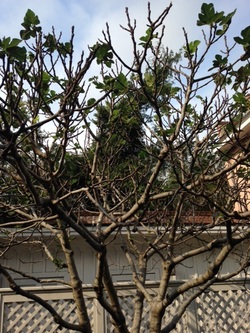
A fungus is among us! Our beloved Ficus carica, more commonly referred to as the Brown Turkey fig, has been stricken by a case of fig rust. This fungus is “the most common fig disease”, and more often than not occurs in “late summer or early fall”, when “humid air or excessive rain” are present (Rhoades, 2018). Our tree just recently acquired rust after the bumper crop this year. We received excessive rainfall here in Wilmington towards the end of the summer; this, coupled with the fact that the flora was very dense and had little to no air circulation due to an abundance of leaves and fruit (the tree produced three times its usual amount of fruit this season!), definitely contributed to our Ficus carica acquiring the fungus. In general the disease is “not fatal, but repeated epidemics will weaken the plant” (Polomski, 2012).
At first fig rust is difficult to detect, and this is primarily due to the fact that “the first signs of fig rust” are “tiny yellow spots” that appear “the underside of the leaves” (Rhoades, 2018). Typically, these spots are initially “only .5 to 1 centimeters across”, so they are very hard to see (Rhoades, 2018)! However, as the fungus progresses, the entirety of the leaf will turn yellow and eventually “fall to the ground” (Rhoades, 2018).

After our tree lost almost all of its leaves an interesting phenomena occurred: a “false spring” effect. As alluded to previously, our tree had a bountiful harvest this year, and that is primarily due to the extra fertilizer that was used to rid the area of ground bees. We didn't want to kill the bees or use chemicals, so in an effort to combat this, our resourceful site manager found that a combination of watering out the bees’ holes and adding plenty of organic material (in our case we used Black Kow, a cow manure mixture) caused the bees to move away and find a new home. However, because the fig rust caused the tree to shed the majority of its leaves and the weather had been fairly warm, the tree had an abundance of excess energy. Ultimately, the flora utilized this energy surplus to create more buds which resulted in new leaves and fruit, causing a “spring” appearance despite the current season. Unfortunately, however, the new leaves also showed signs of rust so several of our wonderful garden club members trimmed those leaves off, leaving just the unaffected ones.
Treatment of the disease can be difficult (Rhoades, 2018). In actuality, “there are very few fungicides that are registered to use on figs”, but the rust “responds best to fungicides that contain copper sulfate and lime” (Rhoades, 2018). In addition, pruning can “help improve air circulation”, which in turn “allows the evaporation of excess water from the leaves of the figs” (Rhoades, 2018). With “proper cleanup and good air circulation,” as well as a “spray regiment” of horticulture oil, it is unlikely that the fig rust will reoccur; and we are sure our Ficus carica will make a full recovery by next season (Rhoades, 2018)!
Interested in the Brown Turkey fig? Take a look at our post to learn all about it!
References
Polomski, B. (2012). Fig. Retrieved from
https://hgic.clemson.edu/factsheet/fig/.
Rhoades, J. (2018). Prevent fig rust: Stopping rust on fig leaves and fruit. Retrieved from
https://www.gardeningknowhow.com/edible/fruits/figs/figs-disease-rust.htm.
References
Polomski, B. (2012). Fig. Retrieved from
https://hgic.clemson.edu/factsheet/fig/.
Rhoades, J. (2018). Prevent fig rust: Stopping rust on fig leaves and fruit. Retrieved from
https://www.gardeningknowhow.com/edible/fruits/figs/figs-disease-rust.htm.

